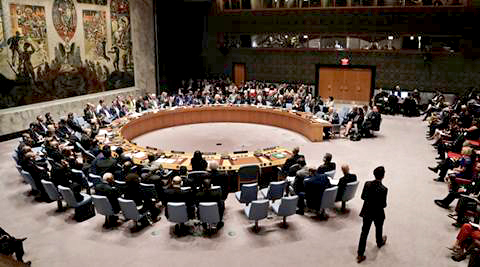United Nations, Oct 4: The UN Security Council has not been discussing the escalating tensions between India and Pakistan, Russia's envoy to the UN and Council president for October said, in a clear snub to Pakistan which had raised the Kashmir issue and surgical strike by India in the world body.
 "I don't want to go there, don't want to go there. No no please, I don't want to go there," Russia's Ambassador to the UN Vitaly Churkin said as he quickly interrupted a question on India and Pakistan tensions during a press briefing here yesterday.
"I don't want to go there, don't want to go there. No no please, I don't want to go there," Russia's Ambassador to the UN Vitaly Churkin said as he quickly interrupted a question on India and Pakistan tensions during a press briefing here yesterday.
Churkin was addressing the media as Russia assumed the Presidency of the 15-nation Council for the month of October.
When asked why he would not comment on the issue, Churkin said "because I am President of the Security Council. The Security Council has not been discussing it (the India-Pakistan situation).
"Sorry sir, I don't want to go there. No comment, no comment, sorry please," Churkin said.
When asked again why he and Russia were "so reluctant" to discuss the India-Pakistan situation, Churkin said, "I'm sure you know. There are so many other things."
Churkin's remarks come as a clear snub to Pakistan, which had approached the Security Council just last week on the surgical strikes conducted by India to target terror launch pads across the Line of Control as well as on the Kashmir issue.
Earlier in the day, UN Secretary General Ban Ki-moon's Deputy Spokesman Farhan Haq was asked what the UN position is on External Affairs Minister Sushma Swaraj's remarks in her address to the UN General Assembly that Pakistan should "abandon" its Kashmir dream since Kashmir is and will remain an integral part of India.
"We have issued a statement on the situation between India and Pakistan. I would refer you back to that," Haq said.
When asked again why the UN did not "say anything" to Swaraj's remarks that Pakistan should stop dreaming about Kashmir, Haq said, "We don't comment on every speech made in the General Assembly, but we have been commenting on the situation on Kashmir, and like I said, we issued a statement on that just last Friday."
Pakistan's envoy to the UN Maleeha Lodhi had met New Zealand's UN Ambassador Gerard van Bohemen, president of the Council for the month of September, and had raised the issue of the surgical strikes in "informal consultations" of the Council.
She had also met UN Secretary General Ban on the issue but the UN Chief had called on the governments of India and Pakistan to address their outstanding issues, including Kashmir, peacefully through "diplomacy and dialogue".
India's Permanent Representative to the UN Ambassador Syed Akbaruddin had last week said that Pakistan approaching the UN Chief and the Security Council over the surgical strikes in PoK has not found any resonance at the world body.
Pakistan Prime Minister Nawaz Sharif too had tried to internationalise the Kashmir issue, raising it with almost every world leader he held bilateral talks with on the sidelines of the 71st session of the UN General Assembly last month.





Comments
Add new comment